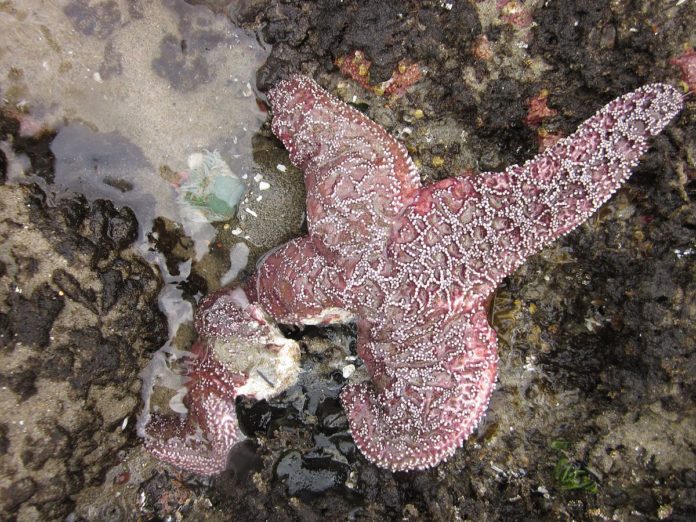Sea Star Wasting Disease (SSWD) has devastated populations of over 20 species of sea star along North America’s western coast since 2013. A new study shows that the disease has spread to the sunflower sea star, a once-abundant predator with a highly significant role in the ecosystem.
SSWD causes its unfortunate hosts to rapidly disintegrate, piece by piece. Some painful white lesions appear at first, but these soon progress to fissures of melting tissue.
The grotesque nature of SSWD has inspired comparisons to an “underwater zombie apocalypse” by co-author Joe Gaydos of UC Davis and to a “blast zone” by Cornell University’s Drew Harvell, a co-lead author in the new study.
“There were arms separating from sea stars, arms walking off by themselves,” commented Harvell in relation to her first experience witnessing the disease on a Seattle beach in 2013.
“That was my first experience of the magnitude of it.”
In that same year, divers began reporting a similarly dramatic picture. Following a dive off the Vancouver coast, John Martin from Kwantlen Polytechnic University noted a “huge mortality event” on the seafloor, with all manner of body parts strewn across the area.
Rampant virus has caused total decline in some areas
At first, it was unclear what was causing the destruction, and suspects including stormy weather and even residual effects of the Fukushima incident were examined. It was in 2014 that researchers identified a virus as the likely culprit: Sea-Star-Associated Denso Virus.
One important caveat is that SSWD is not a guaranteed outcome of the virus. Some sea star species don’t succumb to it, leaving open questions about the exact cause of SSWD.
Regardless, when it does take hold, its ruinous effects are plain to see. This new research from Canadian and international researchers reports a near-total decline in sunflower sea star numbers across its traditional 3,200 km west coast range.
Close to 11,000 diver surveys from 2006 to 2017 were analyzed by the team. Some of the more striking stats include a 100% decline in the California/Oregon region’s deep waters; Washington state retained only 0.8% of previously reported numbers.
Alaska was the only region found to have emerged relatively unscathed, although data were lacking for the northern section.
“At one time plentiful in nearshore waters, the sunflower sea stars right now cannot be found off the California coast and are rare into Alaska,” says Harvell.
“Numbers of the sea stars have stayed so low in the past three years, we consider them endangered in the southern part of their range, and we don’t have data for northern Alaska.”
Global warming may be accelerating predator’s demise
One of the ways the pathogen is suspected to spread is through a multitude of hosts and species which can tolerate it better than the sunflower star. This would help to explain why numbers have been reduced so extremely even in the deep ocean.
Global warming has been named as a leading factor by the authors. Harvell and his team noticed a correlation in their data between higher temperatures and an increased decline of sunflower sea stars.
Although the warming did not necessarily start the disease, the suspicion is that it is exacerbating the situation by providing a boost to whatever microbe is driving SSWD.
“The heat wave in the oceans — a product of increasing atmospheric temperatures – is exacerbating [SSWD],” says Harvell. “It’s a lethal disease, and when you add a higher temperature to that, it kills faster, causing a bigger impact.”
The cascading effects of this decline are profound. Sunflower sea stars heartily munch on sea urchins, whose populations have now exploded. Left unchecked, the urchins are now plowing their way through much of the Pacific Ocean’s kelp forests. Kelp is a special type of seaweed which hosts communities rich in biodiversity, some of whom are commercially valuable like certain crab and fish species.
A bleak picture all round, but there is hope, according to one researcher. The University of Santa Cruz’s Melissa Miner commented that the sunflower sea star can at least still be found across its range despite the minimal numbers.
“My hunch is that this is a fast-growing species, which might have the potential to recover quickly if whatever is causing SSWD subsides,” she says. “I think there is hope.”








































